Electron Donor-Acceptor (EDA) Complexes in Photochemistry
The photochemistry of Electron Donor-Acceptor (EDA) complexes provides a new option to create complex chemical structures (scaffolds) without the need for expensive photocatalysts like iridium or ruthenium. With the recent publication by Paolo Melchiorre and co-authors of an in-depth open-access review of “Synthetic Methods Driven by the Photoactivity of Electron Donor–Acceptor Complexes” in JACS J. Am. Chem. Soc. (2020) 142(12):5461-5476 (Ref 1), we thought it was a great opportunity to discuss modern photochemical approaches using Electron Donor-Acceptor chemistry in synthetic schemes with comparison to the more prevalent photoredox or metalloredox chemistry (Ref 2).
The recent surge of interest in synthetic methodsin photochemistry has been driven by photoredox catalysis, a process in which a photocatalyst utilizes the energy of visible light to drive a reaction between two substrates which would not proceed otherwise (Ref 3,4). In many cases, the excited state of the photocatalyst can act as both an oxidant and reductant as needed, transferring or receiving an electron at the appropriate time (Figure 1). This is the general reaction scheme enabling the multitude of photoredox or metallophotoredox catalytic reactions driven by the ruthenium and iridium photocatalysts that have become prevalent over the last decade .
Figure 1: General roles of an excited photocatalyst as both an oxidant and reductant in photoredox catalysis
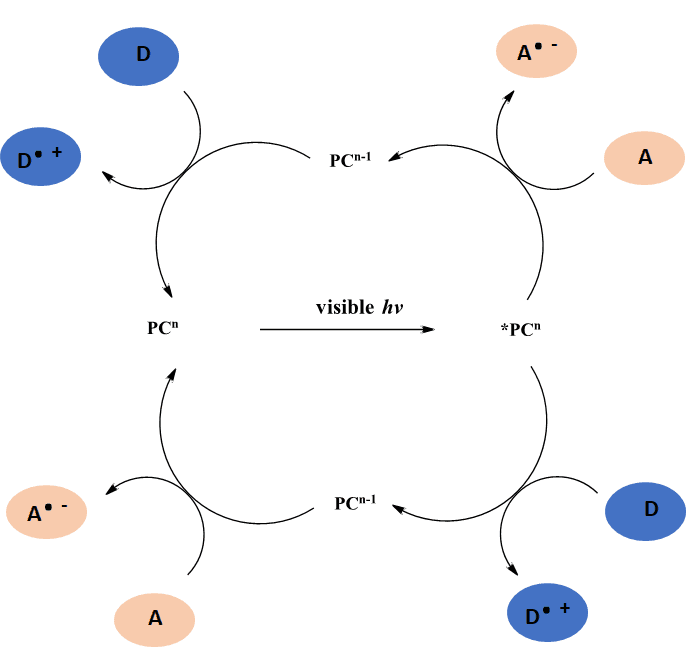
Differing from photoredox catalysis, photoactive electron donor-acceptor complexes do not require a photocatalyst (Figure 2). An electron donor (D) and an acceptor (A), which often do not absorb light individually, upon complexation can absorb visible light to undergo single-electron-transfer generating radical intermediates. This approach affords the opportunity to generate radicals (D+., A-.) from substrates which typically would not absorb in the visible spectrum. The challenge from the synthetic perspective is avoiding the back electron transferreaction, generating unproductively the two monomers in their ground state. The resurgence of electron-donor-acceptor synthetic methods as a field of photochemistry drew from two independent observations in 2013 by the Chatani group with photoredox (Ref 5) and the Melchiorre group studying organocatalysis (Ref 6). Control experiments for specific substrate combinations in the presence of light proceeded in the absence of catalyst.
Figure 2: General Strategy for Photoactivity of Electron Donor Complexes
Direct Coupling Between Electron Donor-Acceptor EDA Complexes
The most straightforward approach to EDA complexes is the direct coupling of the two components upon light activation. In this approach, the viability of the reaction is intrinsic in the electron properties of the two partners and the resulting radicals. One common strategy involves a suitable leaving group within the electron donor-acceptor complex to initiate an irreversible fragmentation outcompeting back electron transfer (Figure 3A). The majority of examples in this class involve C-C bond formation with a few specialized examples for C-S bond formation (see table below).
A limitation of this approach is the requirement of highly polar donor and acceptor molecules which ultimately end up in the product. Alternately, a sacrificial donor can be used to form an EDA complex which upon excitation generates a radical intermediate suitable for reaction with a radical trap (Figure 3B). If the leaving group also can act as a redox auxiliary, then the synthetic scope of potential reactants can expand greatly (Figure 3C). Using the redox auxiliary allows for a suitably polar acceptor to form the EDA complex but generates a radical upon loss of the redox auxiliary that is not biased by internal stabilization or activation in molecule. Versatile redox auxiliaries that can be easily added and removed from desired reactants have the potential to allow synthetic platforms for broad use of the electron donor-acceptor EDA complexes.
Figure 3: Strategies to utilizing Photoactivation of Election Donor-Acceptor Complexes
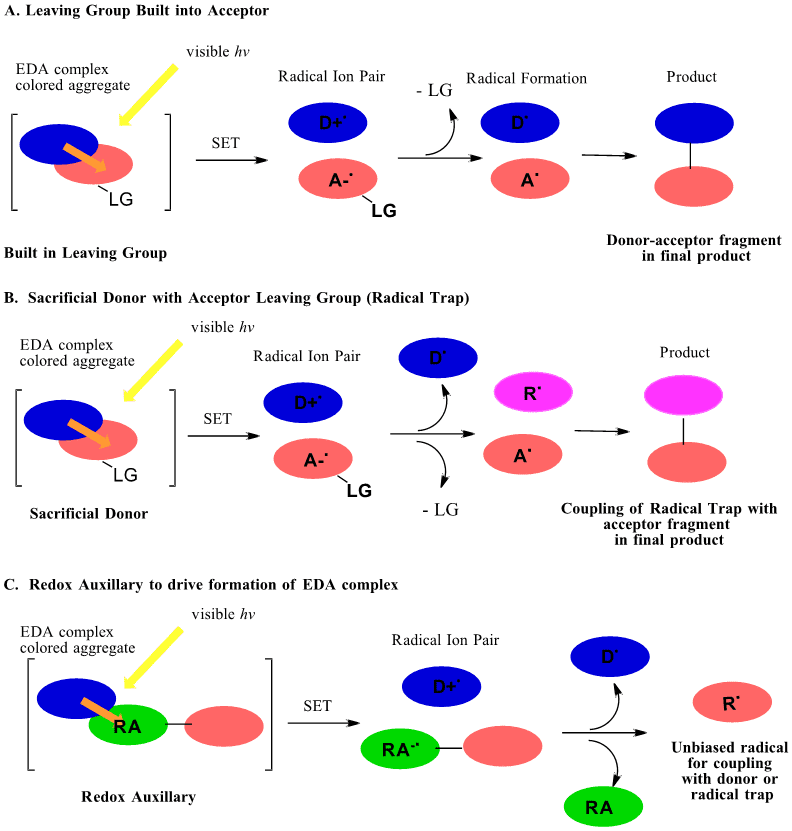
A few Examples of common components for Electron donor-acceptor complexes are shown in Figure 4.
Figure 4: Representative Photoactive Electron Donor-Acceptor complexes
| Type | Donor | Acceptor | Radical Trap | Product |
|
EDA with built in leaving (ref 7) |
 |
 |
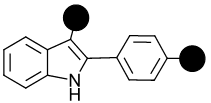 |
|
|
EDA with built in leaving (ref 5) |
 |
 |
||
|
Sacrificial Donor (ref 8) |
 |
 |
 |
 |
|
Sacrificial Donor Redoxauxiliary (ref 9) |
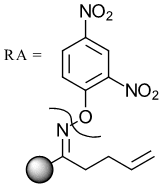 |
 |
||
|
Sacrificial Donor, Redox auxiliary radical trap (ref 10) |
 |
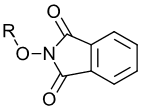 |
Photoactivity of Catalytical EDA complexes
To avoid the use of stoichiometric reagents, an important approach in this field incorporates the formation of the EDA complex into a catalytic cycle. In this approach, a catalyst activates one of the substrates (weakly polar) into a more polar form triggering the formation of the EDA complex which can then be photoactive. This mode of reactivity affords the possibility of asymmetric catalysis with a chiral catalyst. In this scheme a weak donor interacts with an organocatalyst.
Figure 5: Catalyst-donor complex drives EDA formation and initiates catalytic cycle

Outlook
Whether the EDA complex derives from a stoichiometric complex of a donor or acceptor or a more complicated catalytic cycle involving the formation of a pre-catalyst, this review demonstrates the synthetic utility of this exciting field.
Therefore, new redox auxiliaries, chiral ligands, and novel reactions could potentially enable a new approach for building medicinal chemistry libraries generated through photochemistry.
Photochemical reactions proceed in mild conditions with high functional group tolerance and can be applicable to an expansive array of synthetic chemistry. With recent advances and discussions on the process of “photon equivalents” (treating light as a controlled reagent in synthesis) there should be no limit to the scope and scale of photochemical strategies discussed herein and their use in chemical production (Ref 11). We hope that you check out the review for the historical perspective, utility and future challenges of this highly valuable synthetic approach to manipulating radical chemistry.
References:
(1) Giacomo E. M. Crisenza, Daniele Mazzarella, Paolo Melchiorre, Synthetic Methods Driven by the Photoactivity of Electron Donor–Acceptor Complexes, J. Am. Chem. Soc. 2020, 142, 12, 5461-5476. (https://pubs.acs.org/doi/10.1021/jacs.0c01416)
(2) Shaw, M. H.; Twilton, J.; MacMillan, D. W. C. Photoredox Catalysis in Organic Chemistry. J. Org. Chem. 2016, 81, 6898−6926. https://pubs.acs.org/doi/abs/10.1021/acs.joc.6b01449
(3) Marzo, L.; Pagire, S. K.; Reiser, O.; König, B. Visible-Light Photocatalysis: Does It Make a Difference in Organic Synthesis? Angew. Chem., Int. Ed. 2018, 57, 10034−10072. https://onlinelibrary.wiley.com/doi/abs/10.1002/anie.201709766
(4) Rory C. McAtee, Edward J McClain, R.J. Stephenson, Illuminating Photoredox Catalysis, Trends in Chemistry, 1, 1 P111-125. https://www.cell.com/trends/chemistry/fulltext/S2589-5974(19)30009-7
(5) Tobisu, M.; Furukawa, T.; Chatani, N. Visible Light-mediated Direct Arylation of Arenes and Heteroarenes Using Diaryliodonium Salts in the Presence and Absence of a Photocatalyst. Chem. Lett. 2013, 42, 1203-1205. https://www.journal.csj.jp/doi/abs/10.1246/cl.130547
(6) Arceo, E.; Jurberg, I. D.; AÌlvarez-FernaÌndez, A.; Melchiorre, P. Photochemical activity of a key donor-acceptor complex can drive stereoselective catalytic α-alkylation of aldehydes. Nat. Chem. 2013, 5, 750-756. https://www.nature.com/articles/nchem.1727
(7) Kandukuri, S. R.; Bahamonde, A.; Chatterjee, I.; Jurberg, I. D.; Escudero-AdaÌn, E. C.; Melchiorre, P. X-Ray Characterization of an Electron Donor-Acceptor Complex Drives the Photochemical Alkylation of Indoles. Angew. Chem., Int. Ed. 2015, 54, 1485-1489. https://onlinelibrary.wiley.com/doi/abs/10.1002/anie.201409529
(8) Sun, X.; Wang, W.; Li, Y.; Ma, J.; Yu, S. Halogen-Bond- Promoted Double Radical Isocyanide Insertion under Visible-Light Irradiation: Synthesis of 2-Fluoroalkylated Quinoxalines. Org. Lett. 2016, 18, 4638-4641. https://pubs.acs.org/doi/10.1021/acs.orglett.6b02271
(9) Davies, J.; Booth, S. G.; Essafi, S.; Dryfe, R. A. W.; Leonori, D. Visible-Light-Mediated Generation of Nitrogen-Centered Radicals: Metal-Free Hydroamination and Aminohydroxylation Cyclization Reactions. Angew. Chem., Int. Ed. 2015, 54, 14017-14021 https://onlinelibrary.wiley.com/doi/full/10.1002/anie.201507641
(10) Zhang, J.; Li, Y.; Xu, R.; Chen, Y. Donor-Acceptor Complex Enables Alkoxyl Radical Generation for Metal-Free C(sp3)- C(sp3) Cleavage and Allylation/Alkenylation. Angew. Chem., Int. Ed. 2017, 56, 12619-12623. https://pubmed.ncbi.nlm.nih.gov/28809077/
(11) Emily B. Corcoran, Jonathan P. McMullen, François Lévesque, Michael K. Wismer and John R. Naber Photon Equivalents as a Parameter for Scaling Photoredox Reactions in Flow: Translation of Photocatalytic C-N Cross”Coupling from Lab Scale to Multikilogram Scale Angew. Chem Int. Ed. 2020, Online. https://onlinelibrary.wiley.com/doi/abs/10.1002/anie.201915412

